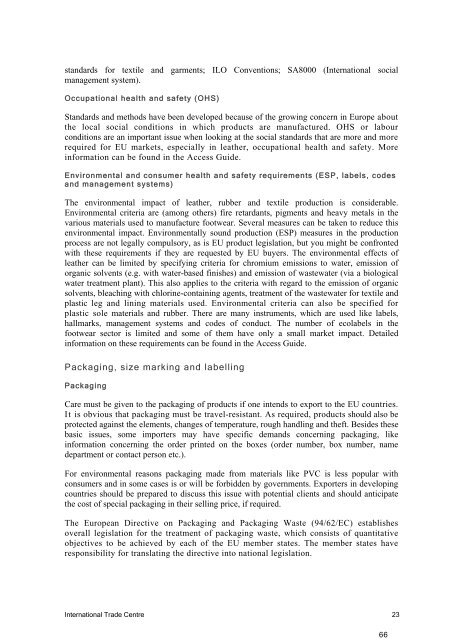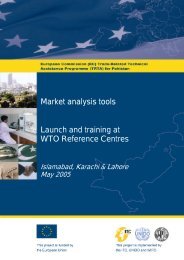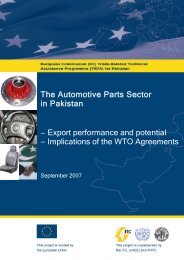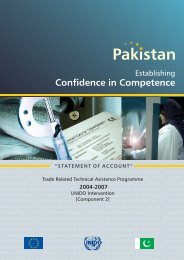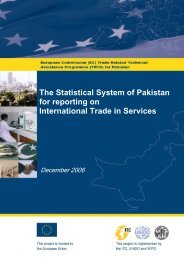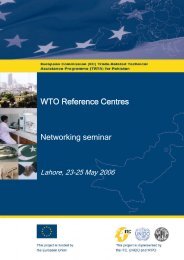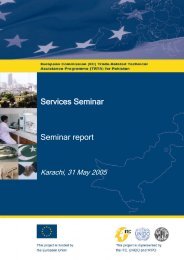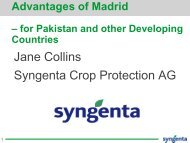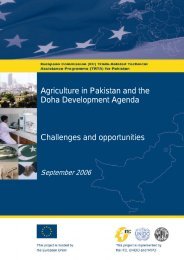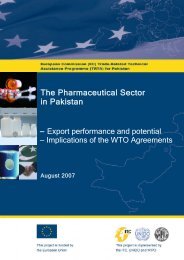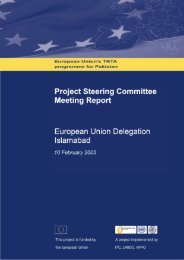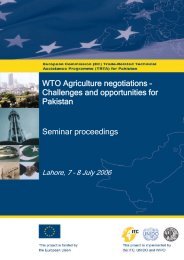The Sports Goods Sector in Pakistan - TRTA i
The Sports Goods Sector in Pakistan - TRTA i
The Sports Goods Sector in Pakistan - TRTA i
You also want an ePaper? Increase the reach of your titles
YUMPU automatically turns print PDFs into web optimized ePapers that Google loves.
66standards for textile and garments; ILO Conventions; SA8000 (International socialmanagement system).Occupational health and safety (OHS)Standards and methods have been developed because of the grow<strong>in</strong>g concern <strong>in</strong> Europe aboutthe local social conditions <strong>in</strong> which products are manufactured. OHS or labourconditions are an important issue when look<strong>in</strong>g at the social standards that are more and morerequired for EU markets, especially <strong>in</strong> leather, occupational health and safety. More<strong>in</strong>formation can be found <strong>in</strong> the Access Guide.Environmental and consumer health and safety requirements (ESP, labels, codesand management systems)<strong>The</strong> environmental impact of leather, rubber and textile production is considerable.Environmental criteria are (among others) fire retardants, pigments and heavy metals <strong>in</strong> thevarious materials used to manufacture footwear. Several measures can be taken to reduce thisenvironmental impact. Environmentally sound production (ESP) measures <strong>in</strong> the productionprocess are not legally compulsory, as is EU product legislation, but you might be confrontedwith these requirements if they are requested by EU buyers. <strong>The</strong> environmental effects ofleather can be limited by specify<strong>in</strong>g criteria for chromium emissions to water, emission oforganic solvents (e.g. with water-based f<strong>in</strong>ishes) and emission of wastewater (via a biologicalwater treatment plant). This also applies to the criteria with regard to the emission of organicsolvents, bleach<strong>in</strong>g with chlor<strong>in</strong>e-conta<strong>in</strong><strong>in</strong>g agents, treatment of the wastewater for textile andplastic leg and l<strong>in</strong><strong>in</strong>g materials used. Environmental criteria can also be specified forplastic sole materials and rubber. <strong>The</strong>re are many <strong>in</strong>struments, which are used like labels,hallmarks, management systems and codes of conduct. <strong>The</strong> number of ecolabels <strong>in</strong> thefootwear sector is limited and some of them have only a small market impact. Detailed<strong>in</strong>formation on these requirements can be found <strong>in</strong> the Access Guide.Packag<strong>in</strong>g, size mark<strong>in</strong>g and labell<strong>in</strong>gPackag<strong>in</strong>gCare must be given to the packag<strong>in</strong>g of products if one <strong>in</strong>tends to export to the EU countries.It is obvious that packag<strong>in</strong>g must be travel-resistant. As required, products should also beprotected aga<strong>in</strong>st the elements, changes of temperature, rough handl<strong>in</strong>g and theft. Besides thesebasic issues, some importers may have specific demands concern<strong>in</strong>g packag<strong>in</strong>g, like<strong>in</strong>formation concern<strong>in</strong>g the order pr<strong>in</strong>ted on the boxes (order number, box number, namedepartment or contact person etc.).For environmental reasons packag<strong>in</strong>g made from materials like PVC is less popular withconsumers and <strong>in</strong> some cases is or will be forbidden by governments. Exporters <strong>in</strong> develop<strong>in</strong>gcountries should be prepared to discuss this issue with potential clients and should anticipatethe cost of special packag<strong>in</strong>g <strong>in</strong> their sell<strong>in</strong>g price, if required.<strong>The</strong> European Directive on Packag<strong>in</strong>g and Packag<strong>in</strong>g Waste (94/62/EC) establishesoverall legislation for the treatment of packag<strong>in</strong>g waste, which consists of quantitativeobjectives to be achieved by each of the EU member states. <strong>The</strong> member states haveresponsibility for translat<strong>in</strong>g the directive <strong>in</strong>to national legislation.International Trade Centre 23


